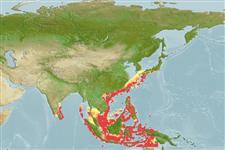Actinopterygii (peixes com raios nas barbatanas) >
Gasterosteiformes (Sticklebacks and seamoths) >
Pegasidae (Seamoths)
Etymology: Pegasus: Taken form the winged horse of Perseus in the ancient Greek, mithology (Ref. 45335); laternarius: From the Latin word 'later' meaning made of bricks.. More on author: Cuvier.
Ambiente / Clima / Intervalo
Ecologia
; marinhas demersal; intervalo de profundidade 30 - 100 m (Ref. 48635). Tropical, preferred ?; 35°N - 11°S, 77°E - 139°E
Indo-West Pacific: Gulf of Manaar, Indian Ocean to the Western Pacific (Gulf of Thailand and South China Sea, along the coast of southern China and Taiwan, extending as far north as Suruga Bay, Japan).
Tamanho / Peso / Idade
Maturity: Lm ? range ? - ? cm
Max length : 8.0 cm SL macho/indeterminado; (Ref. 1418)
Descrição breve
Morfologia | Morfometria
Espinhos dorsais (total): 0; Raios dorsais moles (total): 5; Espinhos anais 0; Raios anais moles: 5; Vértebras: 20. It has a variety of colors and can be dull to bright yellow or blue (Ref. 48635). Preserved body dark brown dorsally and laterally; lighter ventrally. Species with 4 pairs of dorsolateral body plates; 5 pairs ventrolateral body plates; deep pits on dorsal surface of head and within interorbital depression absent; 11 or more tail rings with 9th and 10th fused; suborbital shelf convex, obscuring eye from ventral view; last tail ring without spine on dorsal surface. 5th rays of pectorals stout, much thicker than other rays. No scales on orbit. Distal margin of dorsal and anal fins oblique to horizontal axis of body. Readily identified by its rather short rostrum when juvenile or female; it is more developed in males (Ref. 48635).
Adults lives on muddy bottoms, often collected at depths of about 50 m; larvae are planktonic. Rarely seen diving, except a few localities in Japan where they occur in sheltered muddy habitats (Ref. 48635).
Life cycle and mating behavior
Maturidade | Reprodução | Desova | Ovos | Fecundidade | Larvas
Palsson, W.A. and T.W. Pietsch, 1989. Revision of the Acanthopterygian fish Family Pegasidae (Order Gasterosteiformes). Indo-Pac. Fish. (18):38 p. (Ref. 1418)
Categoria na Lista Vermelha da IUCN (Ref. 115185)
CITES (Ref. 94142)
Not Evaluated
Ameaça para o homem
Harmless
Utilização humana
Mais informação
Nomes comunsSinónimosMetabolismoPredadoresEcotoxicologiaReproduçãoMaturidadeDesovaFecundidadeOvosDesenvolvimento dos ovos
Idade/TamanhoCrescimentoComprimento-pesoComprimento-comprimentoFrequência de comprimentoMorfometriaMorfologiaLarvasDinâmica larvarRecrutamentoAbundância
ReferênciasAquaculturaPerfil para aquaculturaEstirpesGenéticaFrequência dos alelosHereditariedadeDoençasProcessamentoMass conversion
ColaboradoresFotografiasStamps, CoinsSonsCiguateraVelocidadeTipo de nataçãoÁrea branquialOutras referênciasCérebrosVisão
Ferramentas
Relatórios especiais
Descarregue XML
Fontes da internet
